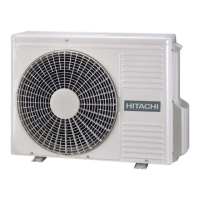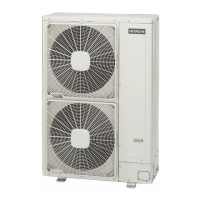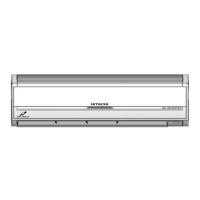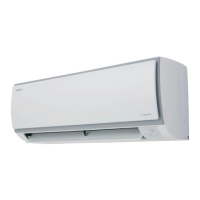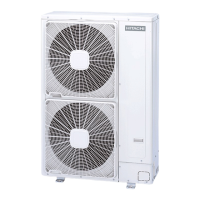CAUTION
• Do not charge OXYGEN, ACETYLENE, or other ammable
and poisonous gases into the refrigerant because an explo-
sion can occur. It is recommended that oxygen free nitrogen
be charged for these types of tests cycle when performing
a leakage test or an airtight test. These types of gases are
extremely dangerous,
• Insulate the unions and are-nuts at the piping connection
part completely.
• Insulate the liquid piping completely to avoid a decrease of
performance; if not, it will cause sweating on the surface of
the pipe.
• Charge refrigerant correctly. Overcharging or insufcient char-
ging could cause a compressor failure.
• Check for refrigerant leakage in detail. If a large refrigerant
leakage occurred, it would cause difculty with breathing or
harmful gases would occur if a re were being used in the
room.
• If the are nut mut is tigthened too hard, the are nut may
crack after a long time and cause refrigerant leakage.
Evacuation and refrigerant charge
Evacuation and refrigerant charging procedure should be perfor-
med according to the following instructions.
The stop valve has been closed before shipment. However, make
sure that the stop valves are closed completely.
- Connect the indoor unit and the outdoor unit with eld-
supplied refrigerant piping.
- Connect the gauge manifold using charging hoses with a
vacuum pump or a nitrogen cylinder to the check joints of
the liquid line and the gas line stop valve.
- Check for any gas leakage at the are nut connection, by
using nitrogen gas to increase the pressure at 4.15MPa
for outdoor units inside of the eld-supplied piping.
- Operate the vacuum pump for 1 to 2 hours until the pres-
sure decreases lower than a pressure of 756 mmHg in
vacuum.
- For charging refrigerant, connect the gauge manifold
using charging hoses with a refrigerant charging cylinder
to the check joint of the liquid line stop valve.
- Charge the proper quantity of refrigerant according to
the piping length (Calculate the quantity of the refrigerant
charge).
- Fully open the gas line stop valve, and slightly open the
liquid line stop valve.
- Charge refrigerant by opening the gauge manifold valve.
- Charge the required refrigerant within the difference range
of ±0.5kg by operating the system in cooling.
- Fully open the liquid line stop valve after completing refri-
gerant charge.
- Continue cooling operation for more than 10 minutes to
circulate the refrigerant.
- Remove the “close” plate from the stop valve and hook the
attached “Open” plate at the stop valve.
Gas line
Liquid line
Liquid stop valve
Gas stop valve
Nitrogen tank
(For air tight test & nitrogen blow
during brazing)
Vacuum cylinder
Manifold
gauge
Outdoor unit
Example of Evacuation and Refrigerant Charge for HVN(P/C)1
14
14.4 REFRIGERANT CHARGE
When the pressure is measured, use the check joint of gas stop
valve, and use the check joint of liquid piping in the gure below.
At that time, connect the pressure gauge according to the fo-
llowing table because of high pressure side and low pressure side
changes by operation mode.
Cooling
Operation
Heating
Operation
Check Joint for Gas Stop Valve Low Pressure High Pressure
Check Joint for Liquid Stop Valve
Exclussive for Vacuum Pump
and Refrigerant Charge
NOTE
Be careful that refrigerant and oil do not splash to the electrical
parts at removing the charge hoses.
Stop valve (liquid)
Stop valve (gas)
14.5 CAUTION OF THE PRESSURE BY CHECK JOINT

